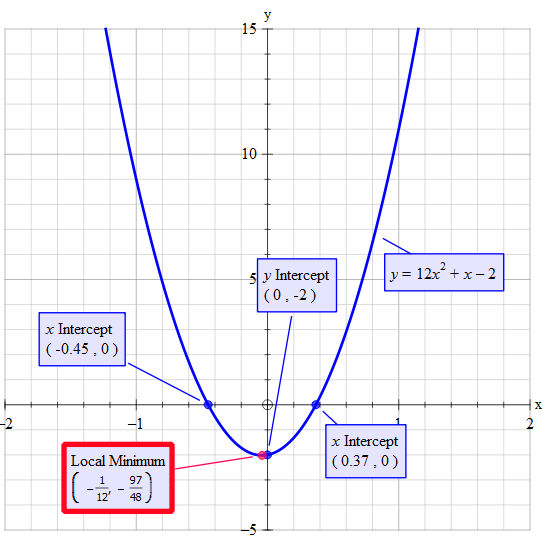Notice they do not ask for the x-intercepts implying that we can 'fiddle it'.
#color(blue)("Determine if max or min")#
The coefficient of #x^2# is positive so the graph is of form #uu# thus the vertex occurs at a minimum.
~~~~~~~~~~~~~~~~~~~~~~~~~~~~~~~~~~~~~~~~~~~~~~~~
#color(blue)("Determine the y intercept")#
#y_("intercept") = -2 larr" read directly off the given function."#
~~~~~~~~~~~~~~~~~~~~~~~~~~~~~~~~~~~~~~~~~~~~~
#color(blue)("Determine the axis of symmetry" -> "vertex")#
Write as:#" "12(x^2+1/12x)-2#
#x_("vertex")=(-1/2)xx1/12 = -1/24 #
#=> "axis of symmetry "->x=-1/24#
~~~~~~~~~~~~~~~~~~~~~~~~~~~~~~~~~~~~~~~~~~~~~~~
#color(blue)("Determine the vertex")#
Substitute #x=-1/24# giving:
#y=12x^2+x-2color(white)(.)->color(white)(.)y_("vertex")=12(-1/24)^2+(-1/24)-2#
#" "y_("vertex")=12/576-1/24-1152/576#
#" "y_("vertex")=12/576-24/576-1152/576#
#" "y_("vertex")=-1164/576#
#" "y_("vertex") =color(white)(-)-2 1/48#
#"vertex "->(x,y)=(-1/24,-97/48)#
~~~~~~~~~~~~~~~~~~~~~~~~~~~~~~~~~~~~~~~~~
#color(blue)("Determine end behaviour")#
As #x# becomes bigger and bigger #12x^2# becomes considerably bigger than the rest. As this state grows further the #+x-2# become insignificant. Thus we are looking at:
#lim_(x->+-oo)y=lim_(x->+-oo) 12x^2 -> 12(+-oo)->+-oo#
~~~~~~~~~~~~~~~~~~~~~~~~~~~~~~~~~~~~~~~~~
#color(blue)("Determine domain and range")#
Range is output #f(x) -> [-97/48,oo)#
Domain is input of #f(x) -> {x: x in RR, x in (-oo,+oo)} #



